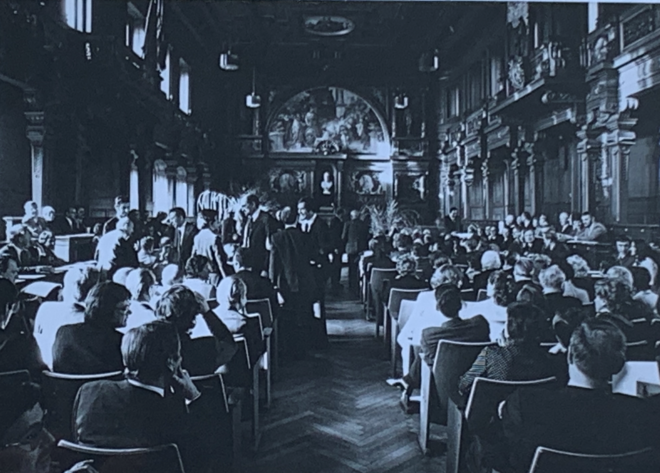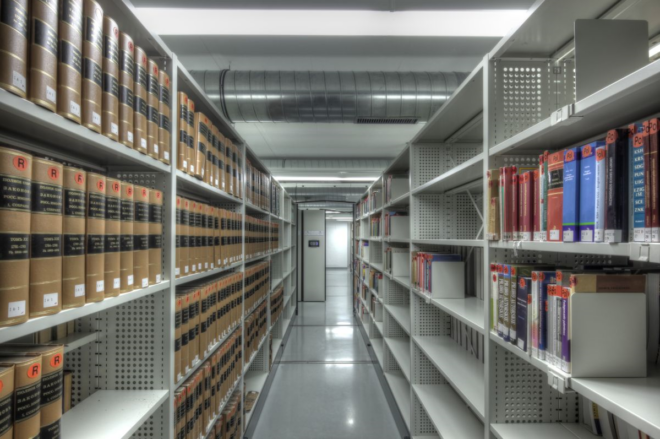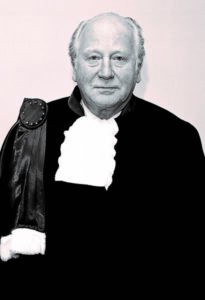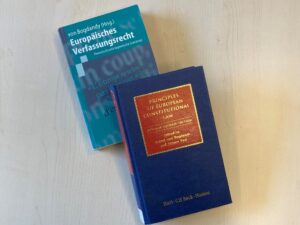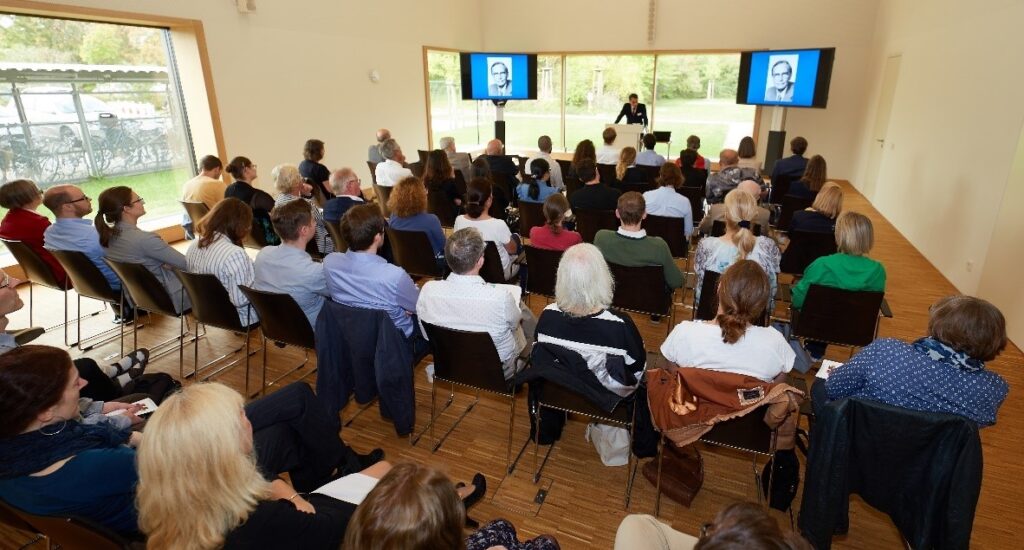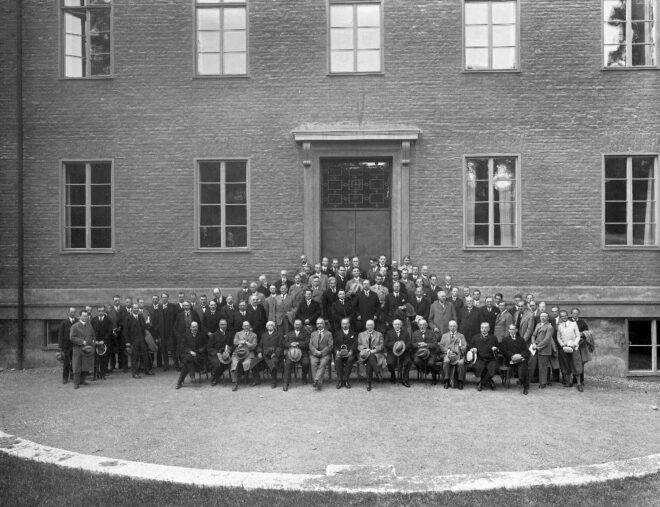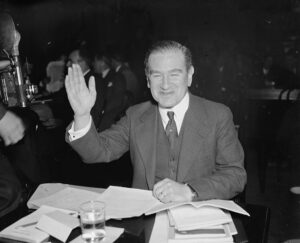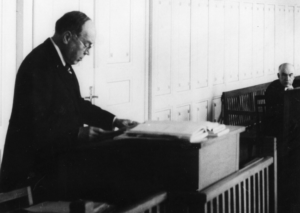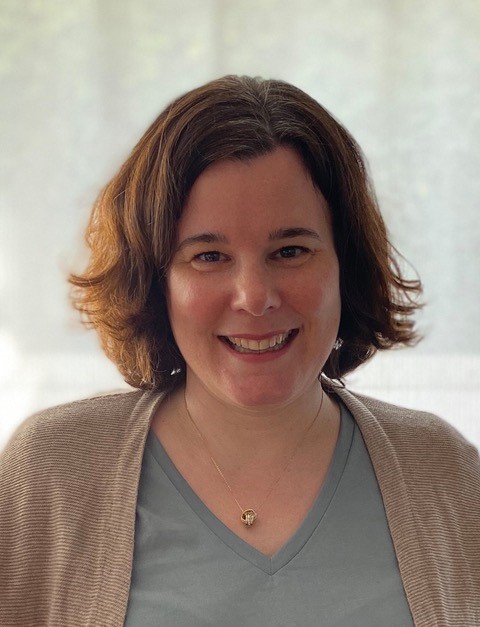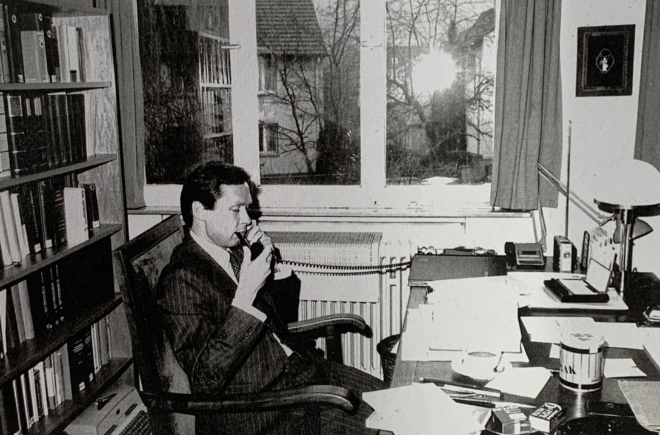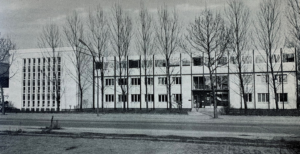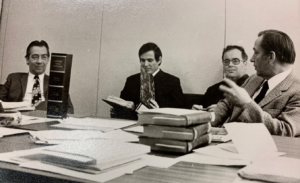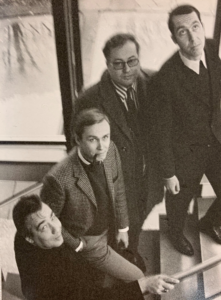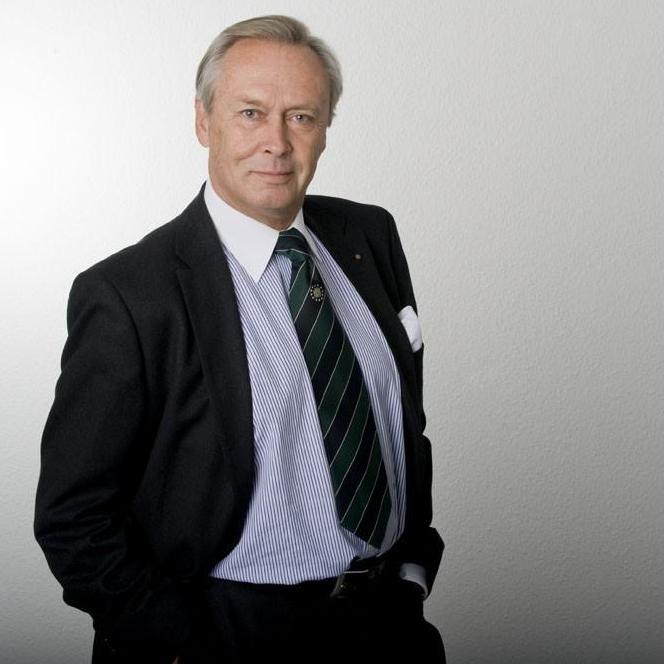Dieser Beitrag, zur Diskussion gestellt als Teil eines Roundtable-Gesprächs im Rahmen der Seminarreihe zur Institutsgeschichte, ist Teil einer gemeinsamen Reflexion über die Zeitgenossenschaft des MPIL. Ist es im Verlaufe seiner Nachkriegsentwicklung auf der Höhe seiner Zeit gewesen, und ist die Zeit auf der Höhe der Wissenschaft der MPIL gewesen? Letzteres wäre der Fall, wenn die Wissenschaft des Völkerrechts den realen Verhältnissen der internationalen Beziehungen vorausgeeilt oder auf dem Wege wäre, die zukünftigen Etappen der Entwicklung der Völkerrechtswissenschaft mitzugestalten.
I. Woran will ich die Zeitgenossenschaft des MPIL (in dem erwähnten doppelten Sinne) festmachen? Unter den verschiedenen methodischen Wegen zur Beantwortung dieser Frage bot sich die mir persönlich nächstliegende Herangehensweise an, nämlich die Identifizierung und Bewertung jener Thematik, welche das Institut seinerseits „um 68“ zum Gegenstand seiner Forschung gemacht und damit auf die völkerrechtswissenschaftliche Agenda gesetzt hat. Die Dekade zwischen der Mitte der 1960er und der 1970er Jahre betrachte ich als die Zeitspanne, die man grob vereinfachend als „um 68“ charakterisieren kann. Diese Jahreszahl vermittelt ja nicht lediglich eine chronologische Information, sondern symbolisiert nachhaltig wirkende gesellschaftliche Ereignisse mit internationaler Ausstrahlung in verschiedene, vor allem westliche Gesellschaften.
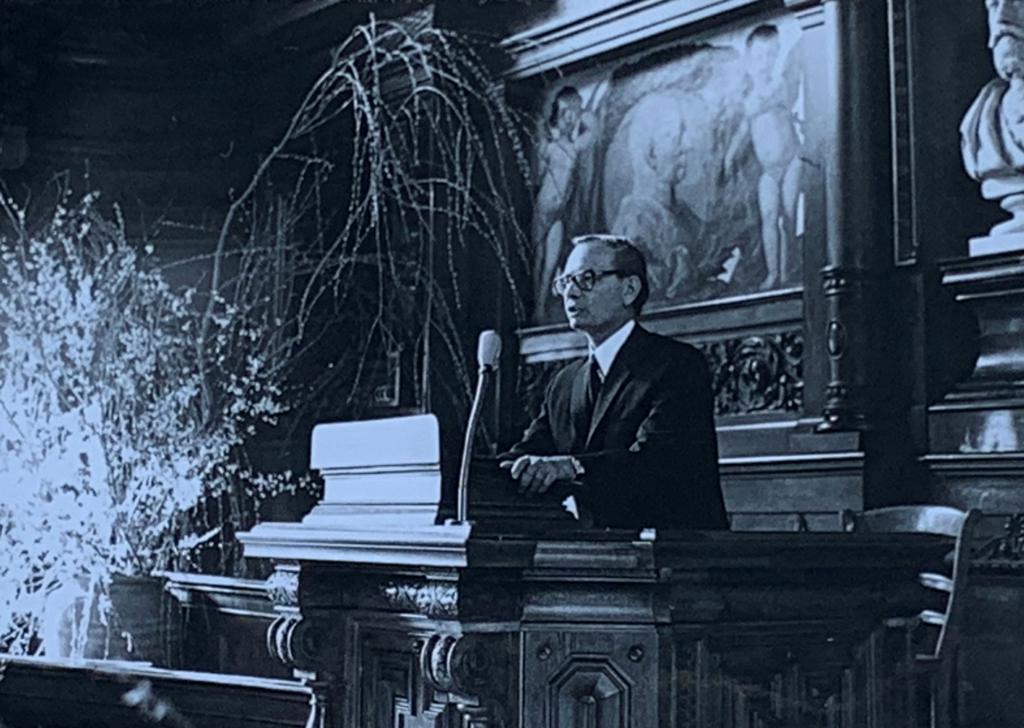
Hermann Mosler 1975 in der Alten Aula anlässlich des 50-jährigen Institutsjubiläums (Foto: MPIL)
Als paradigmatisch betrachte ich das Thema, mit dem Hermann Mosler, der damalige Direktor des MPIL, die Serie der Beiträge eröffnete, die aus Anlass des 1974 gefeierten 50jährigen Bestehens des Instituts in der Zeitschrift für ausländisches öffentliches Recht und Völkerrecht (ZaöRV) veröffentlicht wurden. Es lautete: Völkerrecht als Rechtsordnung. Natürlich war das keine speziell für das Jahrzehnt zwischen der Mitte der 1960er und 1970er Jahre charakteristische wissenschaftliche Fragestellung. Mosler hatte dieses Thema gewählt, weil er damit das Werk des Gründungsdirektors des Kaiser-Wilhelm-Instituts Viktor Bruns ehren wollte, der im Jahr 1929 die ZaöRV gegründet und den ersten Band mit eben dieser Thematik – „Völkerrecht als Rechtsordnung“ eröffnet hatte.
Man könnte sagen, dass dieses Thema für das MPIL nicht nur aus Anlass seiner Jubiläen bedeutungsvoll und würdiger Gegenstand seiner Forschung ist, sondern im Grunde die Ratio seiner Existenz ausmacht. Jubiläen wie das fünf- fünfzig- oder hundertjährige Bestehen des MPIL markieren daher lediglich Stationen, wie sich dieses für den wissenschaftlichen Auftrag des MPIL konstitutive Problem im geschichtlichen Prozess der dazu geführten Diskurse entwickelt hat. Aus Anlass des hundertsten Geburtstages des MPIL daran zu erinnern ist der Sinn der folgenden Überlegungen eines Nicht-Völkerrechtlers.

Original Typoskript des Vortrages „Völkerrecht als Rechtsordnung“ von Viktor Bruns, gehalten am 16. Februar 1927 vor der KWG (Foto: MPIL)
II. Zunächst: Was meinten die beiden Autoren Bruns und Mosler mit der Qualifizierung des Völkerrechts als Rechtsordnung? Gewiss verstanden sie unter dem Begriff Rechtsordnung nicht lediglich eine Ordnung allein des rechtlichen Stoffes, den wir als Völkerrecht klassifizieren, das heißt eine Taxonomie des Rechtsstoffes, der die internationale Dimension des Rechts betrifft. So etwas gehört in den Hörsaal einer Vorlesung über das Völkerrecht und wird in den völkerrechtlichen Reflexionen und Forschungen vorausgesetzt. Wenn das Völkerrecht als Rechtsordnung qualifiziert wird, dann ist damit nicht gemeint, dass dieses Rechtsgebiet eine Ordnung hat und deswegen auch eine Ordnung dieses Rechtsgebietes ist – sinnvollerweise kann damit nur gemeint sein, dass das Völkerrecht eine ordnende Funktion für seinen Gegenstand hat, nämlich die internationale Gemeinschaft.
In modernen Gesellschaften ist die gesellschaftliche Ordnung zugleich eine Rechtsordnung – rechtlich konstituiert und reguliert. Sozialordnung und Rechtsordnung sind weitgehend identisch – selbst der Bruch des Rechts ist ein rechtliches Ereignis. So ist zum Beispiel Diebstahl ein in die Alltagssprache eingegangener Rechtsbegriff für den Vorgang der Wegnahme einer Sache ohne oder gegen den Willen der bestohlenen Person. Das ist gemeint, wenn von der konstitutiven Bedeutung der Norm für die Erkenntnis des rechtlichen Charakters sozialer Beziehungen und Verhältnisse die Rede ist: der von der sinnlich wahrnehmbaren konkreten Realität eines sozialen Verhältnisses abstrahierende Rechtsbegriff prägt Sprache und Bewusstsein einer durch Recht konstituierten Ordnung. Ohne das Recht gäbe es diese Ordnung nicht; ohne das Recht wären die Menschen lediglich ein Haufen im Hobbes’schen Naturzustand, in dem jeder gegen jeden um sein Überleben kämpft.
III. In der Begeisterung der demokratischen Bewegung der Paulskirchenversammlung 1848 und deren Verabschiedung einer Verfassung schrieb der Dichter Ferdinand Freiligrath: „Noch gestern, Brüder, wart ihr nur ein Haufen; ein Volk, o Brüder, seid ihr heut“.
Die gegenwärtig gängige Formulierung für etwas Gleichartiges oder Ähnliches in Bezug auf die internationalen Beziehungen lautet „regelbasierte Weltordnung“. Das ist das Ideal insbesondere der liberalen westlichen Demokratien des globalen Nordens. Eine regelbasierte Ordnung müsste auf globaler Ebene das leisten, was innerstaatlich jedenfalls in jenen Staaten gesichert erscheint: Frieden und Ordnung durch Recht. Wir wissen, dass es das nicht gibt, in dem Zeitalter der Staatlichkeit seit der Mitte des 17. Jahrhunderts auch nicht gegeben hat.
Warum hat es diese Konstellation in den Beziehungen der Staaten nicht gegeben? Die Antwort ist so schlicht wie folgenreich. Die Staaten bilden eine Pluralität, sicherlich mehr als einen Haufen oder eine bloße Menge. Andererseits haben sie sich nicht wie der Freiligrath’sche Haufen zu einem kollektiv handlungsfähigen Verband transformiert – sie befinden sich damit in der paradoxen Situation, dass sie unter diesem Zustand der unorganisierten Vielheit zugleich leiden, wie ihn aber gleichzeitig auch genießen und mit allen Mitteln verteidigen. Sie leiden darunter, dass sie mangels einer über ihnen existierenden sanktionsfähigen Autorität eines internationalen Superstaates in ständiger Sorge um ihre Sicherheit leben, die potentiell von jedem anderen Staat bedroht ist, und sich daher in ständiger kostenintensiver Wehrbereitschaft befinden müssen. Sie genießen diesen Zustand zugleich aber auch, weil sie dank ihrer Souveränität keiner ihnen überlegenen Ordnungsmacht unterliegen und weitgehend ungestört und selbstbezüglich ihre inneren Angelegenheiten regeln können – bis hin zu grausamster Unterdrückung ihrer jeweiligen Völker.
IV. Dieser „Souveränitätspanzer“ verhindert, dass völkerrechtliche Normen einen konstitutiven Status erlangen können. Sie können nicht den soziologischen Rohzustand der internationalen Beziehungen souveräner Staaten in eine Ordnung umwandeln, die einen verbindlichen kollektiven Mehrheitswillen hervorbringen könnte, geschweige denn eine überlegene Autorität, die diesen Willen gegen Widerspruch durchsetzen könnte. Schon der Gegenstand des Völkerrechts ist diffus: laut Präambel der UNO-Satzung sind es die „Völker der Vereinten Nationen“, später im Text dann auch nur die „Vereinten Nationen“, in der Literatur wird auch von der „internationalen Gemeinschaft“, „Staatengemeinschaft“, der „Völkerrechtsgemeinschaft“ oder der „Staatengesellschaft“ gesprochen, zuweilen von der Menschheit (mankind). Bei genauer Betrachtung bilden die Staaten keine Gemeinschaft, sondern eine Gesellschaft. In der präzisierenden Unterscheidung zwischen Vergemeinschaftung und Vergesellschaftung von Max Weber wird letztere als die Existenz einer sozialen Beziehung gekennzeichnet, „wenn und soweit die Einstellung des sozialen Handelns auf rational (wert- oder zweckrational) motiviertem Interessenausgleich oder auf ebenso motivierter Interessenverbindung beruht“.[1] In diesem Sinne kennzeichnet Hedley Bull, Begründer der englischen Schule der internationalen Beziehungen, das Pluriversum der Staaten als „anarchical society“. Damit charakterisierte er eine Konstellation, die durch drei widerspruchsvolle Elemente gekennzeichnet sei: Kriege zwischen den Staaten und Kämpfe um Macht; transnationale Solidarität und Konflikt sowie Kooperation und regulierte Beziehungen zwischen Staaten.[2] Auf ein weniger beachtetes Element dieser Beziehung von Krieg und internationalem anarchischem System hat übrigens der britische Militärhistoriker Michael Howard in einem klugen Essay unter dem Titel The Invention of Peace aufmerksam gemacht.[3]
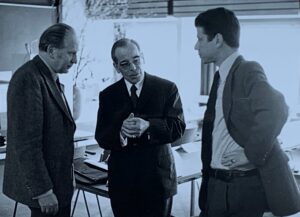
Rudolf Bernhardt, Ernst Friesenhahn und Jochen Frowein auf der Tagung „Völkerrecht als Rechtsordnung“ 1975 (Foto: MPIL)
Die weitgehend anerkannten Eigenheiten der internationalen Ordnung beruhen darauf, dass die Staaten nicht rechtlich konstituiert sind. Staaten sind keine Geschöpfe des Rechts, sondern naturwüchsig aus dem mehr oder weniger gewalttätigen Verkehr der Staaten oder sonstiger Herrschaftsverbände hervorgegangene Gebilde (zum Beispielnach dem Zerfall von Imperien), die ausschließliche Herrschaft über ein umgrenztes Territorium und dessen Bevölkerung ausüben. Während binnenstaatlich die soziale Ordnung durch die konstitutive Wirkung der Verfassung in eine Rechtsordnung transformiert wird, bleibt die Existenz der Staaten in der zwischenstaatlichen Sphäre ein bloßes Faktum. Kelsen bezeichnete bekanntlich das Völkerrecht als eine „primitive Rechtsordnung“. Damit bezog er sich darauf, dass die generellen Normen des Völkerrechts nicht durch ein gesondertes Gesetzgebungsorgan erzeugt werden, sondern durch die „Glieder der Rechtsgemeinschaft“ selbst, das heißt die Staaten.[4] Sie haben keine Institution hervorgebracht, die mit der selbständigen Wahrung der Gesamtinteressen der „Gemeinschaft“ betraut wurde. Dass dies auch unter dem Schirm der UN-Charta gilt, zeigen deren Artikel 24 und 25. Danach handeln die Mitglieder des Sicherheitsrates bei der Erfüllung ihrer Hauptverantwortung für die Wahrung des Weltfriedens nicht im Namen und im Interesse einer in den Vereinten Nationen verfassten Gemeinschaft der Staaten und deren Völker, sondern im Namen der Summe der Mitglieder der Vereinten Nationen, also der Staaten. Sie bleiben in ihrer Pluralität und Souveränität die Quelle der Legitimität der Beschlüsse des Sicherheitsrates. Die Verbindlichkeit der Beschlüsse des Sicherheitsrates ergibt sich folglich nicht aus einer strukturellen Überlegenheit eines Gesamtwillens über die Einzelwillen der Staaten; sie folgt aus der Übereinkunft der einzelnen Mitglieder der Vereinten Nationen, „die Beschlüsse des Sicherheitsrates im Einklang mit dieser Charta anzunehmen und durchzuführen“ (Artikel 25). Quelle der Legitimität der Beschlüsse des Sicherheitsrates sind die Übereinkünfte der Staaten, die damit auch die Interpretationshoheit über deren jeweiligen Inhalt und damit über das Maß der Verbindlichkeit innehaben.
Zum Mitglied einer „anarchischen Gesellschaft“ nach der erwähnten Konzeption von Bull wird ein Staat als Faktum erst durch die Anerkennung als Staat – erst dadurch erwirbt er den Status eines internationalen Rechtssubjektes.[5] Beides – Anerkennung und Völkerrechtsfähigkeit – sind Begriffe des Völkerrechts. Ihre Geltung und Anwendung schaffen eine eigene soziale Wirklichkeit und erlösen damit die faktische Wirklichkeit eines „naturhaften“ Nebeneinanders von ungleich machtvollen souveränen Herrschaftsgebilden von ihrem Verharren in der rohen Version eines Hobbes’schen Naturzustandes.
V. Was durch die Geltung dieser völkerrechtlichen Normen, im Verbund mit dem elementaren, in der Regel rechtsethisch fundierten Grundsatz pacta sunt servanda[6] bewirkt wird, ist nichts weniger als der erste Schritt hin zu einer Rationalisierung des rohen Zustandes einer Vielzahl machtopportunistisch agierender Souveräne in eine normativ inspirierte Konstellation eines geordneten Nebeneinanders. Man kann also den genannten völkerrechtlichen Normen einen konstitutiven Charakter zusprechen.
Rechtfertigt das die These vom Völkerrecht als Rechtsordnung? Es kommt darauf an, welche Ansprüche wir an den Begriff der völkerrechtlichen Ordnung stellen. Verstehen wir darunter die oben erwähnte „regelbasierte internationale Ordnung“, so wird man die Frage wohl verneinen müssen. Denn beim gegenwärtigen Stand der ungezügelt ausgetragenen internationalen Konflikte ist von einer ordnenden, geschweige denn steuernden Macht des Völkerrechts wenig zu sehen. Für uns Heutige muss der Frieden noch erfunden werden. Wir werden uns wohl mit der bescheideneren Idee einer regelorientierten Ordnung zufriedengeben müssen. Die Kluft zwischen regelbasiert und regelorientiert ist das Feld der internationalen Politik. Sie benötigt dringend die Expertise und Kreativität der völkerrechtlichen Profession und ihres deutschen Hortes, des Heidelberger MPIL. Dessen Jubiläum zum hundertjährigen Bestehen ermutigt zu kühnen Hoffnungen und Wünschen.
[1] Max Weber, Wirtschaft und Gesellschaft. Grundriss der Verstehenden Soziologie, Tübingen: Mohr 1972, 21.
[2] Hedley Bull, The Anarchical Society. A Study of Order in World Politics, London: Macmillan1977, 41.
[3] Michael Howard, The Invention of Peace. Reflections on War and International Order, London: Yale University Press 2000.
[4] Hans Kelsen, Reine Rechtslehre, 2. Aufl. (1960), 5. Neudruck, Wien: Verlag Österreich 2000, 323 ff.
[5] Vgl. Wilfried Schaumann, Anerkennung, in: Hans-Jürgen Schlochauer (Hrsg.), Wörterbuch des Völkerrechts, Bd. I, Berlin: De Gruyter 1960, 47 ff.; Hermann Mosler, Völkerrechtsfähigkeit, in: Hans-Jürgen Schlochauer (Hrsg.), Wörterbuch des Völkerrechts, Bd. III, Berlin: De Gruyter 1962, 665 ff.
[6] Hierzu Werner Kägi, Pacta Sunt Servanda, in: Hans-Jürgen Schlochauer (Hrsg.), Wörterbuch des Völkerrechts, Bd. II, Berlin: De Gruyter 1961, 711-716.


